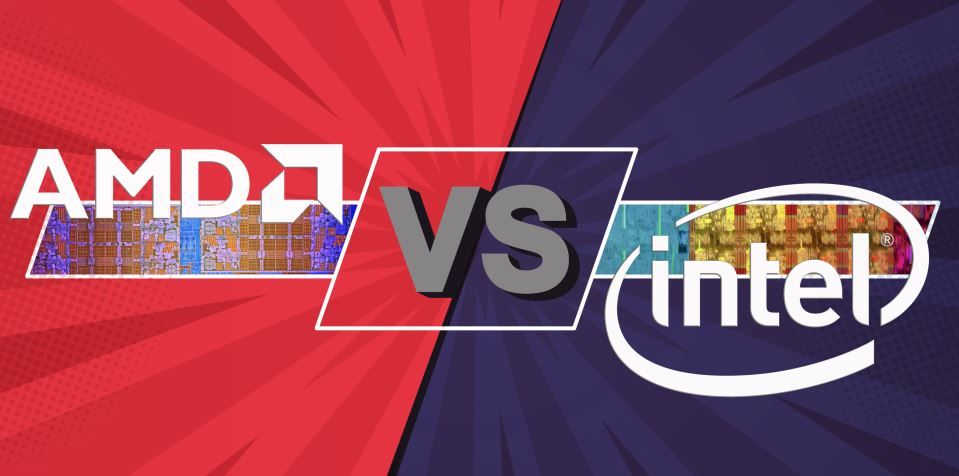
(Image credit: Tom's Hardware)
If you're looking for the best CPUs for gaming or the best workstation CPU, or just one of the best budget CPUs, there are only two choices: AMD and Intel. That fact has spawned an almost religious following for both camps, and the resulting AMD vs Intel flamewars make it tricky to get unbiased advice about the best choice for your next processor. But in many cases, the answer is actually very clear: AMD's chips win for most users looking for the best balance of performance in both gaming and productivity at a more accessible price point. Additionally, AMD's lineup of specialized X3D CPUs is the hands-down winner for PCs focused on gaming.
This article covers the never-ending argument of AMD vs Intel desktop CPUs (we're not covering laptop or server chips). We judge the chips on five criteria based on what you plan to do with your PC: pricing, performance, driver support, power consumption, and security, giving us a clear view of the state of the competition. We'll also discuss the process nodes and architectures influencing the moving goalposts. However, each brand has its strengths and weaknesses, so which CPU brand you should buy depends mostly on what blend of features, price, and performance is important to you.
The 'Arrow Lake Core Ultra 200S series builds on Intel's hybrid architecture formula but leverages a new design philosophy that constrains gaming performance. However, the chips do provide strong performance in single- and multi-thread productivity workloads, along with improved energy efficiency.
AMD's answer is its Zen 5 Ryzen 9000 series. These chips debuted with a fizzle on the gaming front, but subsequent firmware and operating system updates have improved the overall performance significantly, making these chips the bang-for-the-buck leader for most users looking for a balanced system.
AMD's powerful gaming-optimized Ryzen 9000 "X3D" models utilize a breakthrough 3D chip-stacking tech to take the lead in gaming performance, as you can see in our Ryzen 9 9800X3D review that finds the 9800X3D to be the fastest gaming CPU on the planet, bar none. AMD has also leveraged this X3D tech with its older architectures to make incredibly value-centric gaming chips, like the Ryzen 5 5600X3D. The gains in gaming performance are phenomenal, so much so that the competition against Intel chips isn't even close, giving AMD a walk-in touchdown for gaming PCs.
AMD vs Intel: Which CPU is Best?
AMD's relentless onslaught with its Zen-based processors has redefined our expectations for both the mainstream desktop and the HEDT markets, originally catching Intel flatfooted as it remained mired on the 14nm process and Skylake architectures due to execution challenges. The past several years have seen AMD CPUs go from value-focused and power hungry chips to designs that deliver more cores, more performance, and lower power requirements than Intel's competing chips, especially in gaming.
Intel fought back by slowly adding features and cores across its product stack, resulting in negative side effects, like more power consumption and heat. That only highlighted the company's struggles on the design and fabrication side of its operation.
AMD isn't taking the challenge lying down, as its new lineup of 4nm Ryzen 9000 X3D chips use the company's new second-gen 3D V-Cache tech to impart tremendous gains in gaming performance, giving AMD the lead in sheer gaming performance.
Intel's chips also hold the crown on overclockability for both core and memory frequencies, and not by a small margin. If you spend the cash on a Z-series motherboard, you'll attain far more overclocking headroom than you'll get with the Ryzen 9000 chips. You can see an example in our How to Overclock a CPU feature.
An AMD processor is the better choice depending on your needs, like if you prize stability, the lowest power consumption, or forward compatibility with your motherboard for a few more chip generations. AMD also has amazing gaming performance on tap with its X3D chips, and they don't suffer from lower performance in productivity applications like they used to. They do cost a premium, but they are the no-compromise solution for leading performance in both disciplines.
For now, if you want the best blend of gaming and application performance, all within a reasonable power consumption envelope, not to mention forward compatibility with your existing motherboard, Team Red deserves your hard-earned dollars.
AMD vs Intel CPU Pricing and Value
Pricing is the most important consideration for almost everyone, and AMD has generally been hard to beat in the value department. The company's standard Ryzen 9000 series models often sell below MSRP, with the flagship Ryzen 9 9950X often selling for $100 less than its suggested etail price. The company's gaming-optimized X3D processors do come at a premium, but those models provide more than enough gaming performance to justify the price tag.
In contrast, Intel's Core Ultra 200S series processors tend to stubbornly hover around their MSRP. While they hold advantages in productivity performance, it isn't enough to justify the markup. Additionally, their severely lagging gaming performance makes them a tough sell against AMD's X3D gaming lineup; it's simply a no-contest.
Family | AMD | Intel |
|---|---|---|
Threadripper - Xeon W | $2,399- $10,000 | $949 - $5,889 |
AMD Ryzen 9 - Intel Core i9 | $469 - $699 | $549 - $599 |
AMD Ryzen 7 - Intel Core i7 | $359 -$480 | $384 - $404 |
AMD Ryzen 5 - Intel Core i5 | $250 - $279 | $270 - $319 |
AMD Ryzen 3 - Intel Core i3 | $95 - $120 | $97 - $154 |
AMD still freely allows overclocking on all chip models and all but its A-Series motherboards (see our article on CPU overclocking), which is a boon for enthusiasts. Meanwhile, Intel still charges a premium for its overclockable K-Series chips, but you'll also need to shell out for a pricey Z-Series motherboard for the privilege of overclocking your processor — Intel doesn't allow full overclocking on B- or H-series motherboards, but has enabled memory overclocking on its B and H chipsets, though.
AMD generally has better coolers than Intel — most of AMD's bundled coolers are suitable for at least moderate overclocking — but the company no longer includes them with any of the 'X' models. Intel also doesn't throw in a cooler for its pricey overclockable K-series SKUs. So be sure to budget for a cooler (and a beefy one, at that) if you plan on overclocking an Intel processor.
Both Intel and AMD include a bundled cooler with their downstream SKUs (non-K for Intel, non-X for AMD), but Intel's coolers are flimsy and 'good enough' at best. We've even seen cases where Intel's stock coolers don't provide full performance at stock settings. AMD, in contrast, has solid coolers that often even provide a bit of headroom for overclocking. Intel did slightly bulk up its coolers, but the aesthetic and slight thermal improvements aren't enough to match AMD's competent coolers, and they aren't available on all models.
Pricing isn't entirely dictated by what you pay for the chip, though — we also have to factor in platform pricing. Intel's Arrow Lake chips drop into the same LGA 1851 interface that isn't backward-compatible with prior-gen Intel chips. And there is no guarantee it will support the next-gen options, either, which means you'll probably have to buy a new board if you want to upgrade in the future.
AMD supported its AM4 socket for five generations of chips, and while that platform will live on for some time with the Ryzen 5000 chips slotting in as value alternatives, the company's new AM5 socket houses its newest Ryzen 7000 chips. AMD says it will support this socket until 2025+, so it is possible that it could enjoy similar longevity to AM4, thus giving enthusiasts a long upgrade path.
AMD followed Intel in exiting the high end desktop (HEDT) segment entirely, marking the end of an era. Now you'll have to step up to workstation-class processors from both companies to attain more cores and connectivity, as seen in our Threadripper Pro 5995WX and 5975WX reviews. In either case, AMD owns the performance tier for the best CPUs for workstations, so it can charge eye-watering premiums as a result — and it does. The company even excluded its lowest-priced Threadripper models from retail, creating a $2,399 bar for entry. That puts workstation chips far out of the reach of the majority of enthusiasts.
Winner: AMD. When comparing Intel vs AMD CPUs, Team Red currently offers the best overall performance and value across the full spectrum of price ranges. AMD owns the gaming category in a landslide win with its X3D processors, and it also has strong performance in productivity applications. Intel's Arrow Lake does have the lead in some facets of performance, such as in single-threaded applications, but that isn't enough to outweigh the higher pricing and lower performance in multi-threaded applications and gaming.
Additionally, AMD has a strong lead in the platform department, too. The AM5 platform supports both Ryzen 7000 and 9000 processors and will play host to at least one more generation of processors. If tradition holds, we could see it soldier on for several more generations, though AMD has remained coy about the details. In contrast, Intel's LGA 1851 platforms support just one generation of chips — Arrow Lake — and they aren't officially said to support Intel's next-gen chips, either. However, Intel might release an Arrow Lake Refresh generation, but the inherent limitations of the chip design mean it will almost certainly not be a contender against AMD, especially in gaming. That makes a new Intel motherboard a bad investment.
Intel vs AMD CPU Gaming Performance
In the AMD vs Intel CPU gaming performance battle, AMD's X3D processors hold the lead in all critical price bands. Below, we have a wide selection of collective gaming performance measurements for the existing chips in the different price bands. You can see a much more holistic view in our CPU Benchmarks Hierarchy.
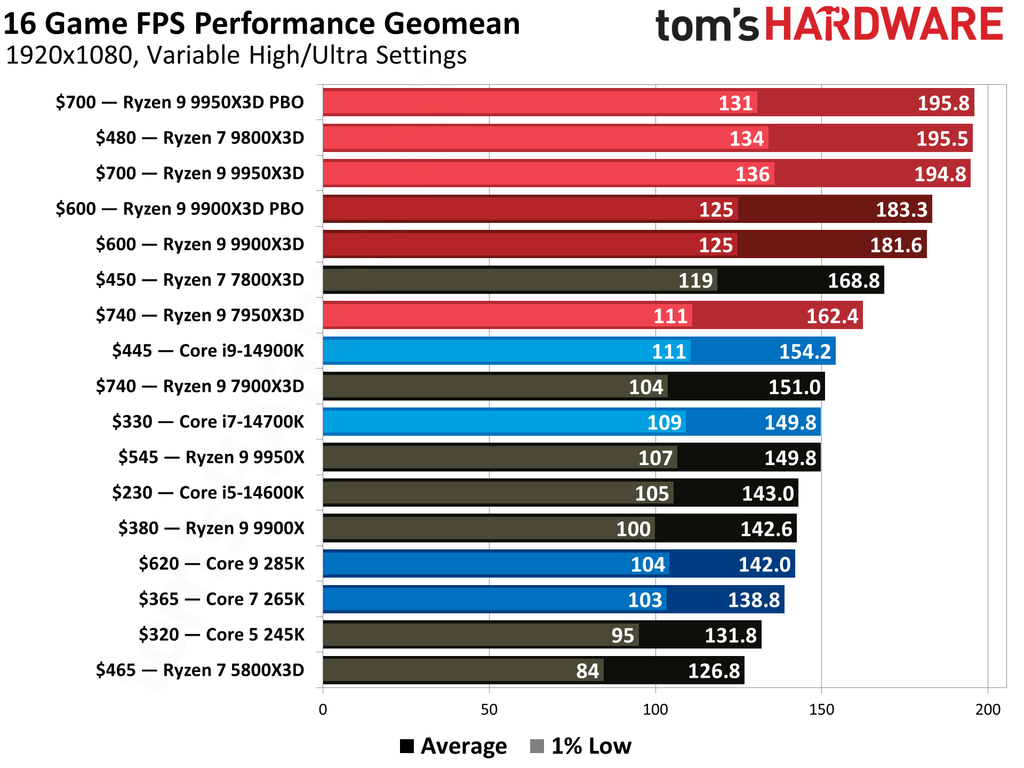
(Image credit: Tom's Hardware)
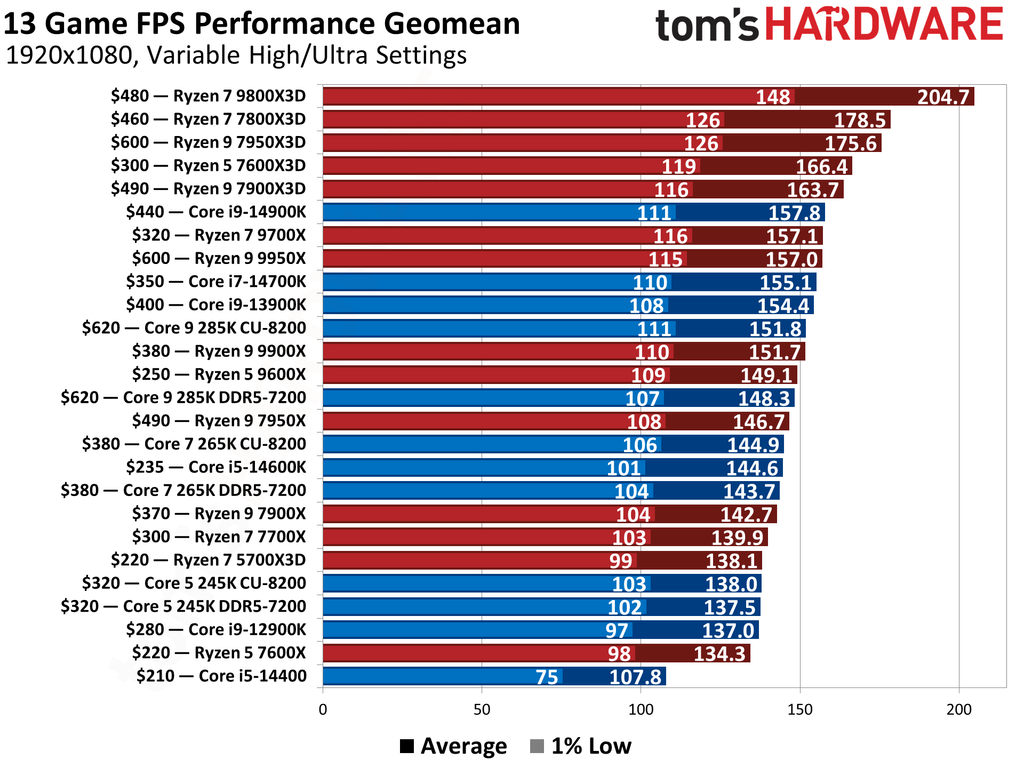
(Image credit: Tom's Hardware)
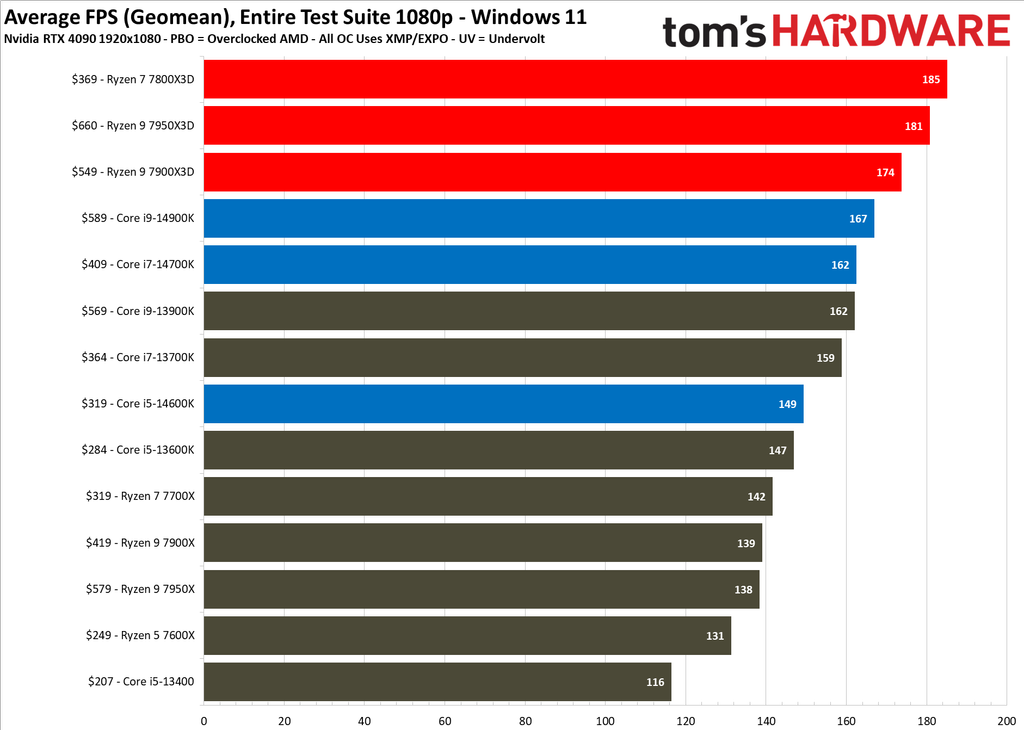
(Image credit: Tom's Hardware)
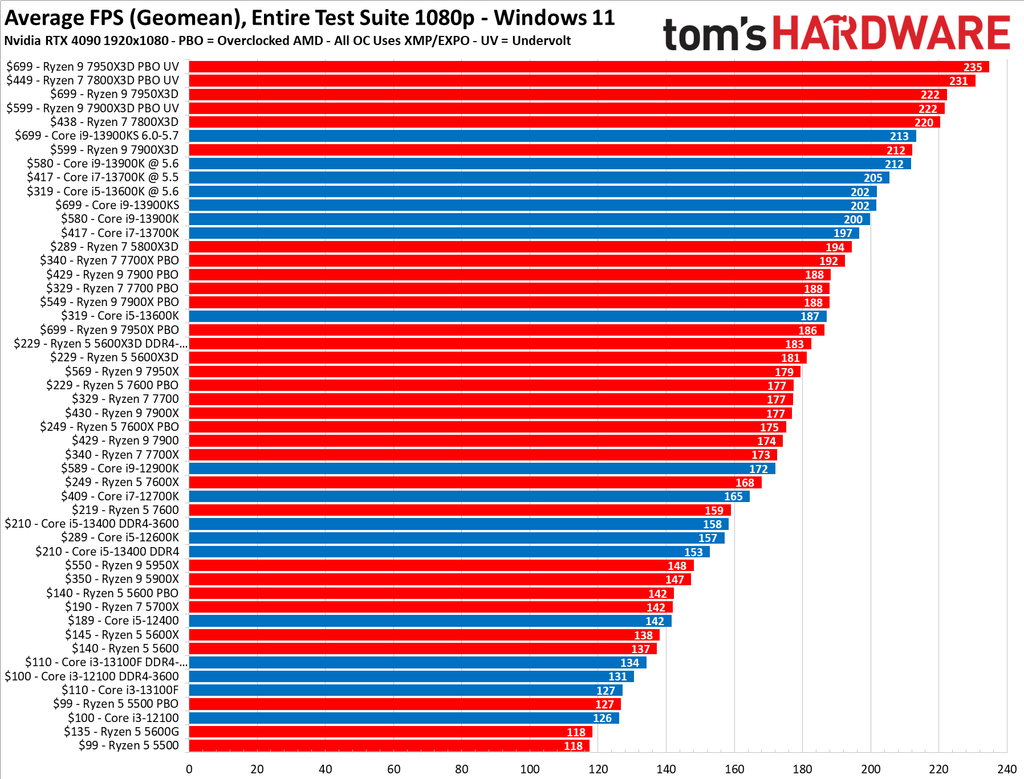
(Image credit: Tom's Hardware)
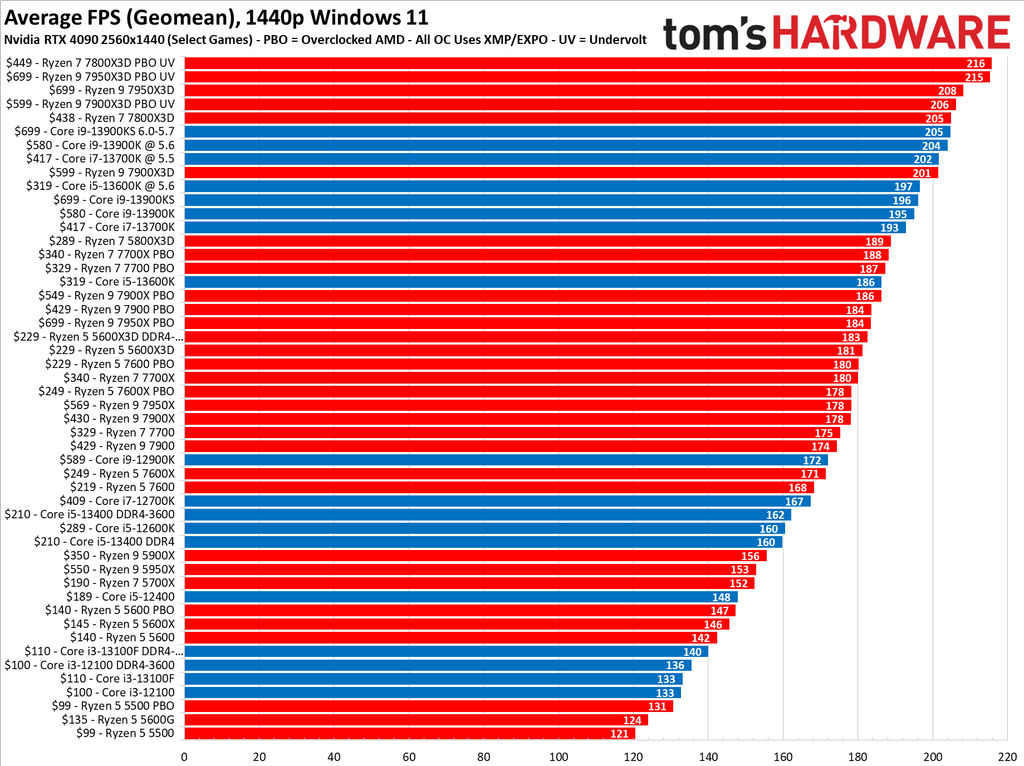
(Image credit: Tom's Hardware)
As you can see, AMD's standard 'Granite Ridge' Ryzen 9000 models take the lead over Intel's current-gen Core Ultra 200S 'Arrow Lake' processors, and the gaming optimized Ryzen 9000X3D chips, which cost more than the standard models, take an overwhelming lead, often by 30% or more.
Intel's current-gen Core Ultra 7 285K is the new flagship, but its unique tile-based (chiplet) design has a negative impact on gaming performance, so it isn't as fast as the prior-gen models in gaming. That leaves the Core i9-14900K as the fastest Intel gaming chip, and it often sells at a steep discount. However, it isn't as fast in productivity applications as AMD's latest products, making it a tough sell to drop back to the previous-gen model. Additionally, the 14900K isn't as fast in gaming as the AMD X3D models.
AMD's standard Ryzen 9000 models, like the flagship Ryzen 9 9950X, are faster in gaming than Intel's Core Ultra 200S series, but Intel's previous-gen 14900K holds the edge. However, AMD's X3D models, like the Ryzen 7 9800X3D and the Ryzen 9 9950X3D, are the fastest gaming chips on the planet, beating Intel's current-gen chips by 30+%. These chips also deliver the full performance of the standard models in productivity workloads, eliminating the tradeoffs associated with the X3D models that we've seen in the past. The X3D models do come at a premium, but they justify their price tag with the fastest gaming performance money can buy.
Kicking your resolution up to 1440p and beyond typically pushes the bottleneck back to the GPU, so you won't gain as much from your CPU's gaming prowess. However, a bit of extra CPU gaming performance could pay off if you plan on updating your graphics card (see our best graphics cards) with a newer generation while keeping the rest of your system intact. We expect most builds in the mid-range to come with lesser GPUs, which generally serve as an equalizer in terms of CPU performance.
In terms of integrated graphics performance, there's no beating AMD. The company's current-gen Cezanne APUs offer the best performance available from integrated graphics with the Ryzen 7 5700G and Ryzen 5 5600G. Hit those reviews for a dedicated breakdown, or head to our CPU Benchmark hierarchy for even more detail.
Winner: AMD. AMD's standard Ryzen 9000 models deliver solid performance in gaming, beating Intel's current-gen models, but they trail the previous-gen Intel chips. However, the Ryzen 9000X3D models take the unequivocal lead in gaming by massive margins, giving AMD an easy win in the gaming department. The previous-gen Raptor Lake Refresh models are a distant second in gaming performance, and they aren't as performant as the Ryzen 9000 models in productivity applications, making them a tough choice as an alternative.
AMD vs Intel Productivity and Content Creation Performance
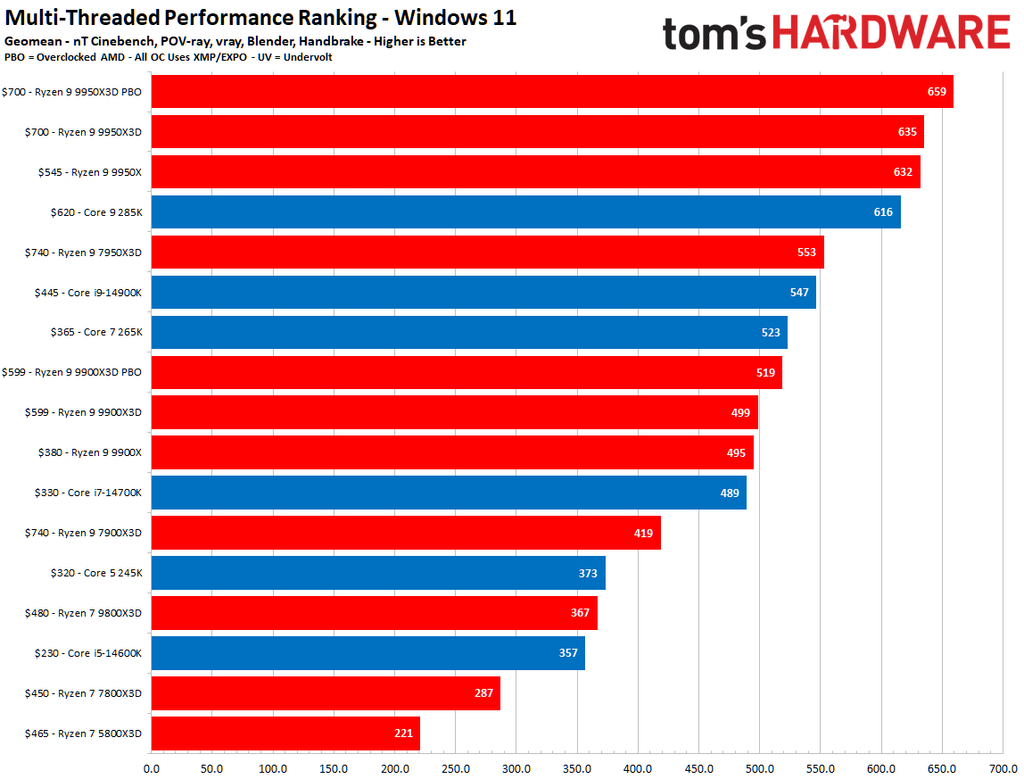
(Image credit: Tom's Hardware)
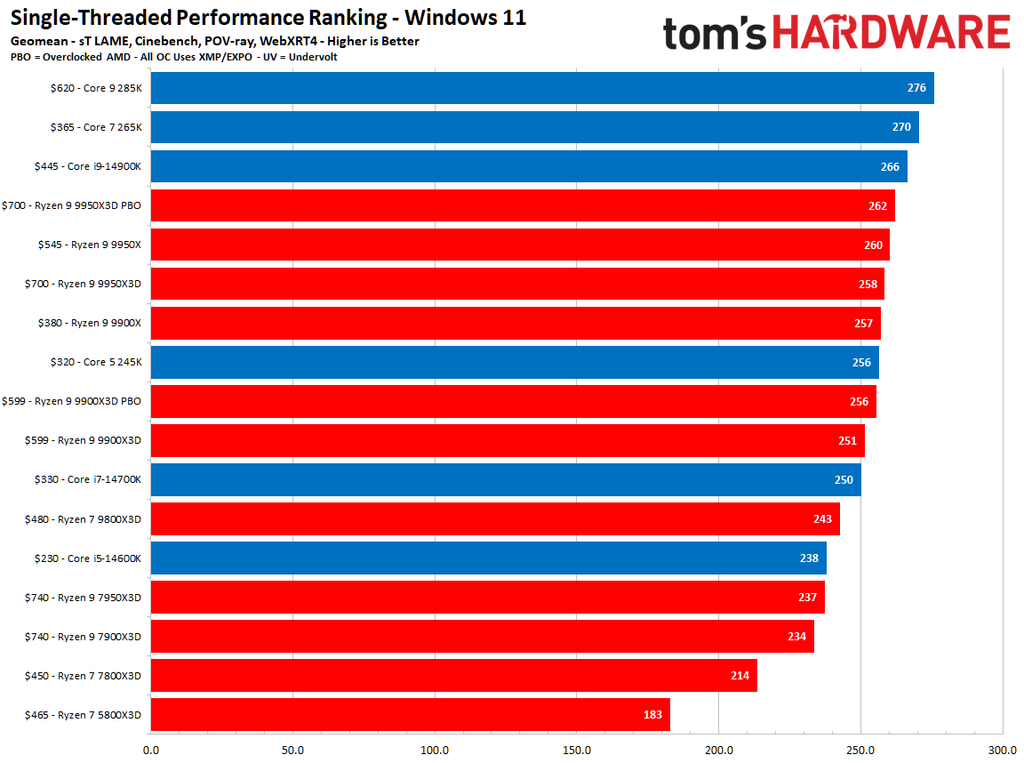
(Image credit: Tom's Hardware)
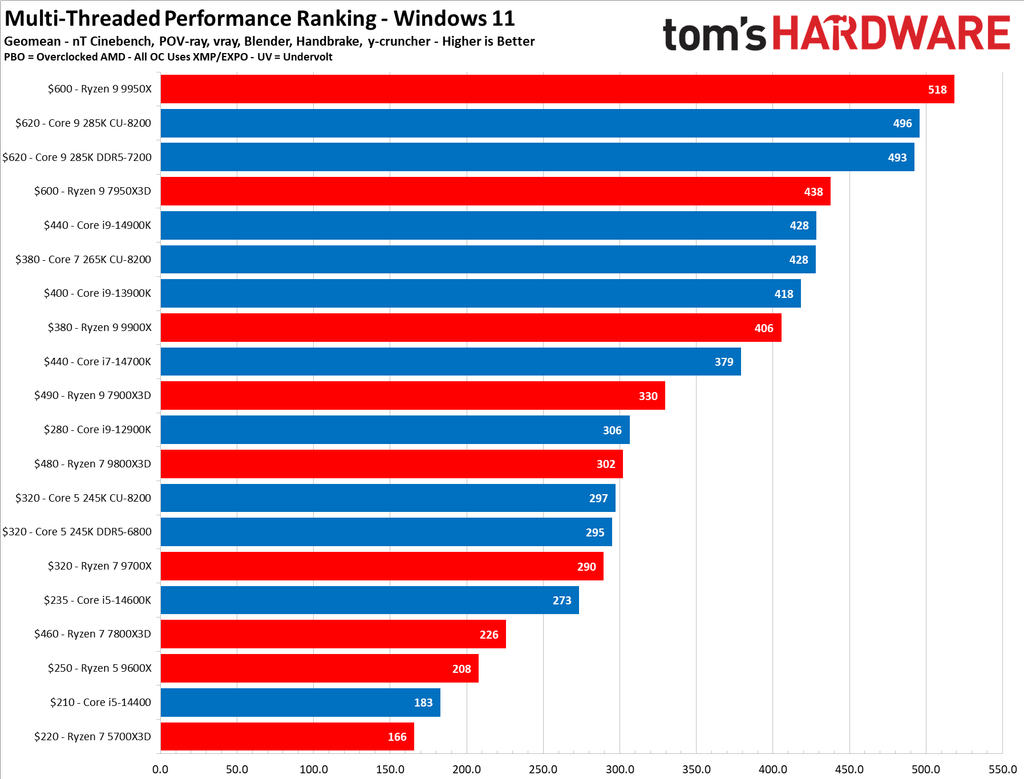
(Image credit: Tom's Hardware)
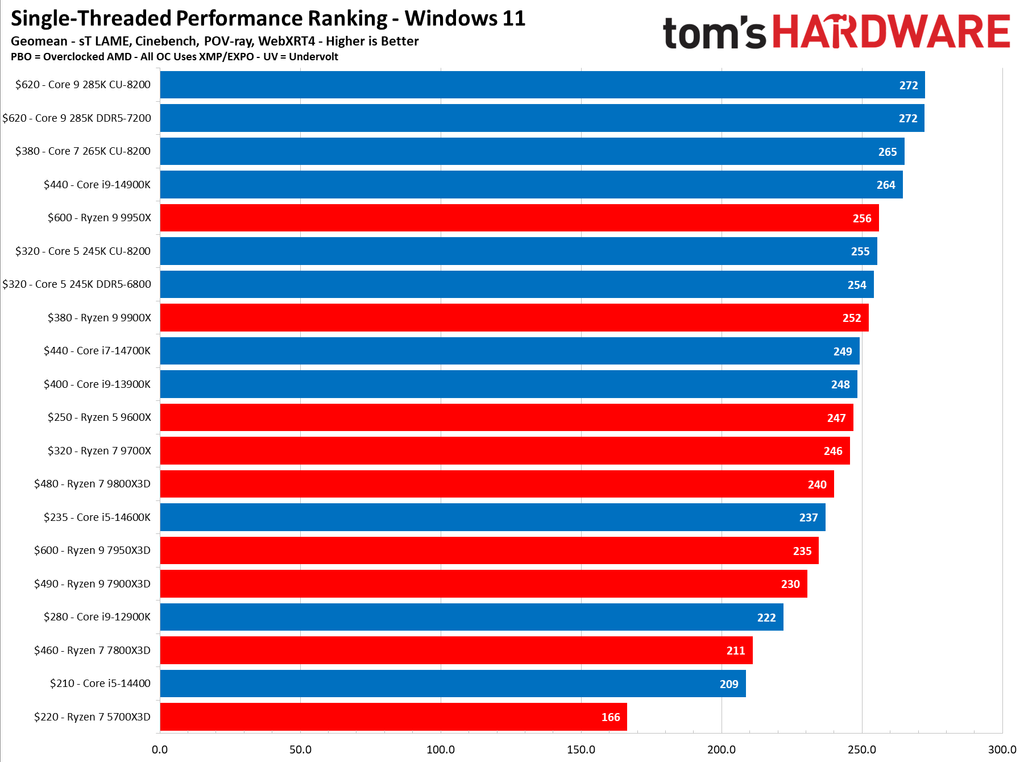
(Image credit: Tom's Hardware)
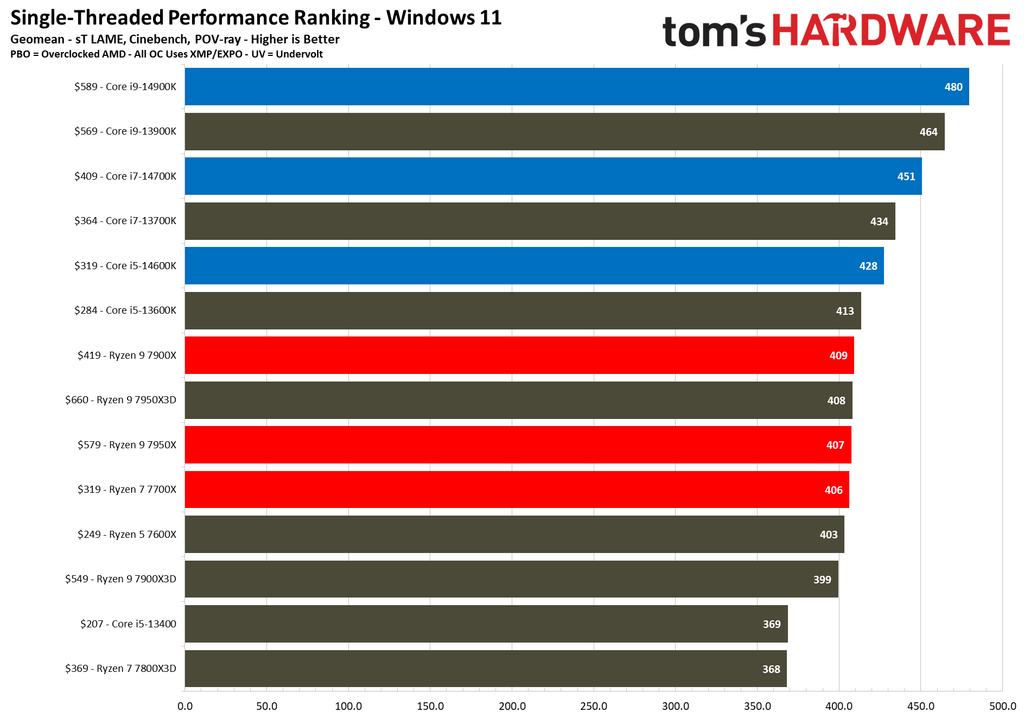
(Image credit: Tom's Hardware)

(Image credit: Tom's Hardware)

(Image credit: Tom's Hardware)
In the non-gaming performance battle of AMD vs Intel CPUs, Intel's Arrow Lake chips have made great strides against AMD's finest, but they fail to deliver a tangible enough lead over AMD's core-heavy models to make productivity performance a make-or-break buying decision. AMD leads in overall multi-threaded performance with its Ryzen 9 9950X3D and 9950X by a slim margin, but Intel keeps a solid grip on the lead in single-threaded applications.
Arrow Lake marks Intel's continuation of using a mixture of two types of cores for the mainstream desktop PC. The big performance cores (P-cores) are best for latency-sensitive work, giving Intel the uncontested lead in single-threaded applications. The efficiency cores (E-cores) step in to add some additional heft in threaded and background applications, which pays big dividends in heavily-threaded content creation and productivity applications.
In contrast, AMD continues to leverage its tried-and-true P-core only design, which also supports AVX-512, a big consideration for those who leverage powerful productivity applications that employ the high-performance instructions.
Solid performance in single-threaded work equates to faster performance in all manner of workloads, particularly day-to-day applications that rely on snappy responsiveness from the processor. The Core 7 285K has taken the uncontested lead in single-threaded performance across the full suite of our benchmarks, but that's Intel's most expensive mainstream CPU. If you're searching for snappy single-threaded performance, the other Arrow Lake processors also take the lead over competing AMD processors. Overall, Intel's Arrow Lake family holds the single-threaded performance crown.
Winner: Tie. For professionals on the hunt for the highest performance in content creation and productivity applications, the winner of AMD vs Intel CPUs is a tie overall. The chips are closely matched in multi-threaded work, with the lead going to AMD, but Intel enjoys a lead in single-threaded applications. Overall, the decision will come down to the types of workloads you tend to use the most.
AMD vs Intel Processor Specifications and Features
AMD has its Ryzen 3, 5, 7, and 9 lines, while Intel breaks up its offerings into Core Ultra 3, 5, 7, and 9. For the sake of brevity, we'll focus on the top chips in the respective families to compare Intel vs AMD CPUs based on specs and features. Be aware that both companies have value options within each tier, but we can get a general sense of the landscape with these (relatively) smaller lists. We're using both vendors' recommended pricing and street pricing.
CPU | Street (MSRP) | Arch | Cores / Threads (P+E) | P-Core Base / Boost Clock (GHz) | E-Core Base / Boost Clock (GHz) | Cache (L2/L3) | TDP / PBP or MTP | Memory |
|---|---|---|---|---|---|---|---|---|
Ryzen 9 9950X3D | $699 | Zen 5 X3D | 16 / 32 | 4.3 / 5.7 | — | 144 MB (16+128) | 170W / 230W | DDR5-5600 |
Ryzen 9 7950X3D | $740 ($699) | Zen 4 X3D | 16 / 32 | 4.2 / 5.7 | — | 144MB (16+128) | 120W / 162W | DDR5-5200 |
Ryzen 9 9950X | $545 ($599) | Zen 5 | 16 / 32 | 4.3 / 5.7 | — | 80MB (16+64) | 170W / 230W | DDR5-5600 |
Core Ultra 9 285K | $620 ($589) | Arrow Lake | 24 / 24 (8+16) | 3.7 / 5.7 | 3.2 / 4.6 | 76MB (40+36) | 125W / 250W | CUDIMM DDR5-6400 / DDR5-5600 |
Ryzen 9 9900X3D | $599 | Zen 5 X3D | 12 / 24 | 4.4 / 5.5 | — | 140MB (12+128) | 120W / 162W | DDR5-5600 |
Ryzen 9 7900X3D | $740 ($599) | Zen 4 X3D | 12 / 24 | 4.4 / 5.6 | — | 140MB (12+128) | 120W / 162W | DDR5-5200 |
Ryzen 7 9800X3D | $480 | Zen 5 X3D | 8 / 16 | 4.7 / 5.2 | — | 104MB (8+96) | 120W / 162W | DDR5-5600 |
Ryzen 7 7800X3D | $450 ($449) | Zen 4 X3D | 8 / 16 | 4.2 / 5.0 | — | 104MB (8+96) | 120W / 162W | DDR5-5200 |
Ryzen 9 9900X | $380 ($469) | Zen 5 | 12 / 24 | 4.4 / 5.6 | — | 76MB (12+64) | 120W / 162W | DDR5-5600 |
| Core Ultra 7 265K / KF | $365 ($394) / $339 ($379) | Arrow Lake | 20 / 20 (8+12 | 3.9 / 5.5 | 3.3 / 4.6 | 66MB (36+30) | 125W / 250W | CUDIMM DDR5-6400 / DDR5-5600 |
| Ryzen 7 9700X | $289 ($329) | Zen 5 | 8 / 16 | 3.8 / 5.5 | — | 40MB (8+32) | 65W / 88W / 105W | DDR5-5600 |
| AMD Ryzen 5 9600X | $210 ($269) | Zen 5 | 6 / 12 | 3.9 / 5.4 | — | 38MB (6+32) | 65W / 88W | DDR5-5600 |
| Core Ultra 5 245K / KF | $309 / $294 | Arrow Lake | 14 / 14 (6+8) | 4.2 / 5.2 | 3.6 / 4.6 | 50MB (26+24) | 125W / 250W | CUDIMM DDR5-6400 / DDR5-5600 |
In the battle of AMD vs Intel CPUs, AMD's Ryzen 9, Ryzen 7, and Ryzen 5 families square off against Intel's Core Ultra 9, Core Ultra 7, and Core Ultra 5.
The Ryzen 9 9950X3D is one of the fastest gaming chips on the market, essentially tying its sibling, the Ryzen 7 9800X3D. As mentioned, these chips do carry a premium, though. The 9950X3D holds the throne as the best all-around processor for gaming, single- and multi-threaded work, while the Core Ultra 9 285K takes a few leads in some types of multi-threaded work. However, that comes at a big tradeoff in performance in the other categories.
A similar story plays out in the decidedly more mainstream Ryzen 7 and Core Ultra 7 markets. Honestly, these are the chips the majority of gamers should buy if they have enough cash. Here, Intel's Core 7 285K offers nearly the same gaming performance as the Core Ultra 9 285K, albeit at the expense of some threaded horsepower in productivity applications, but at a far lower price point. The Ryzen 7 9800X3D easily leads this category, though, with the fastest gaming performance on the market and strong performance in threaded applications.
Winner: Intel. When you compare AMD vs Intel CPU specifications, you can see that Intel offers options with lower pricing and more performance. Intel's chips also provide support for DDR4, an important consideration in these early days of DDR5 adoption.
AMD vs Intel CPU Power Consumption and Heat
When comparing AMD vs Intel CPU power and heat, the former's 4nm TSMC process node makes a big difference. Power consumption comes as a byproduct of design choices, like lithography and architecture. However, higher power consumption often correlates to more heat generation, so you'll need beefier coolers to offset the heat output of greedier chips.
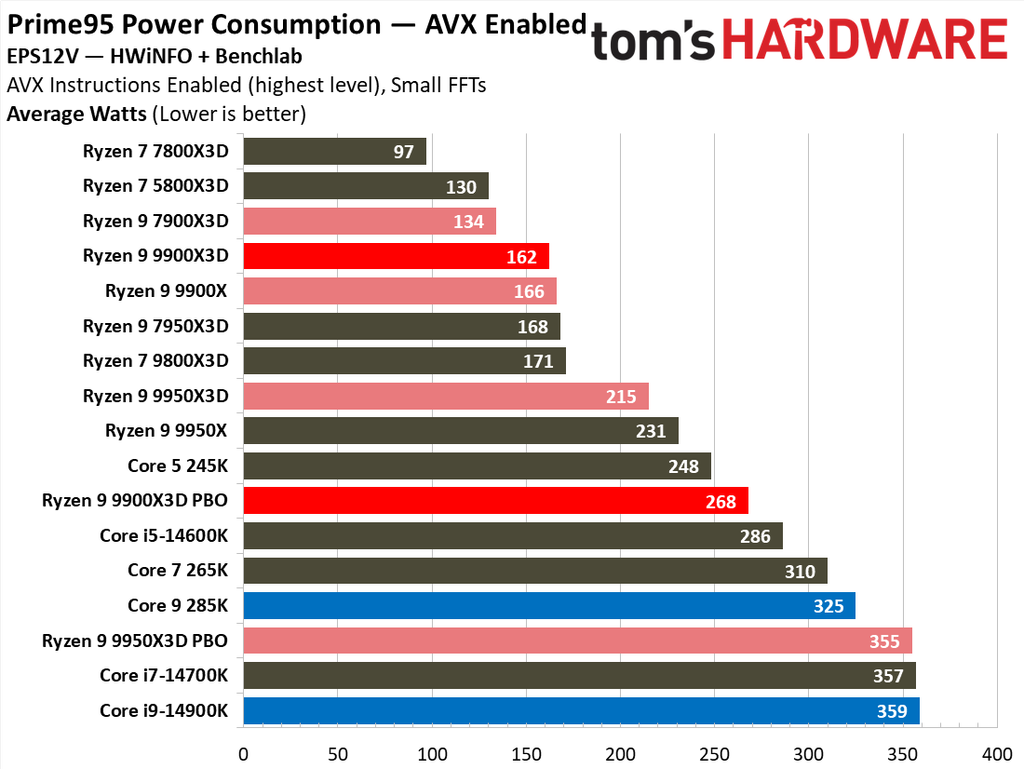
(Image credit: Tom's Hardware)
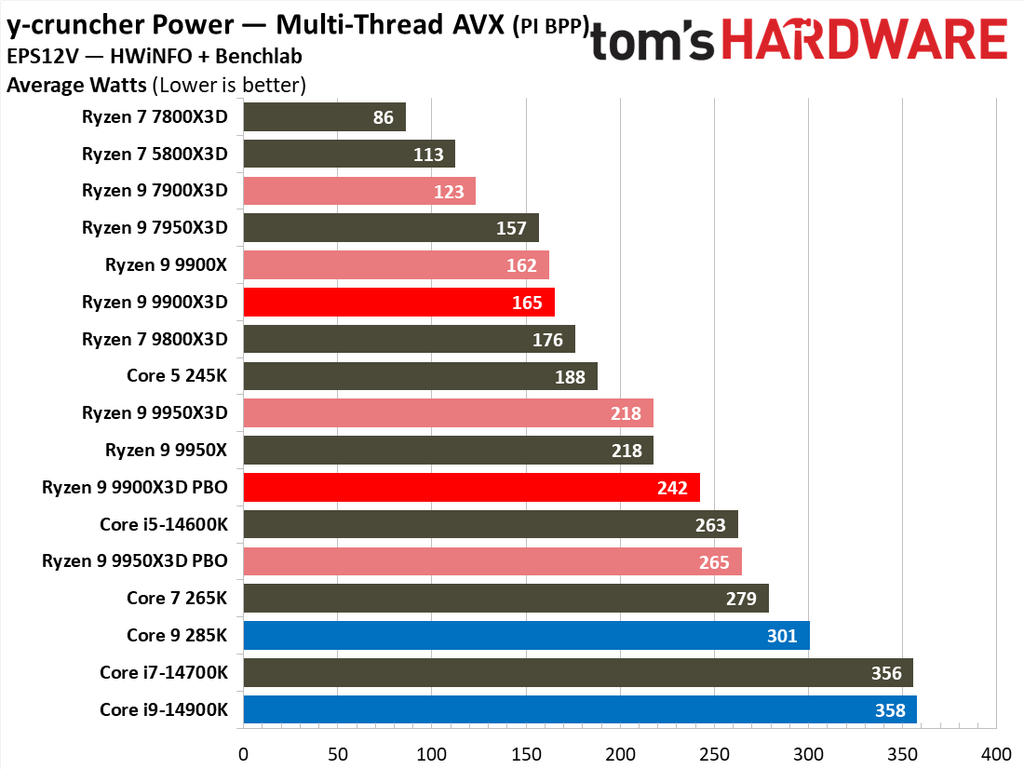
(Image credit: Tom's Hardware)
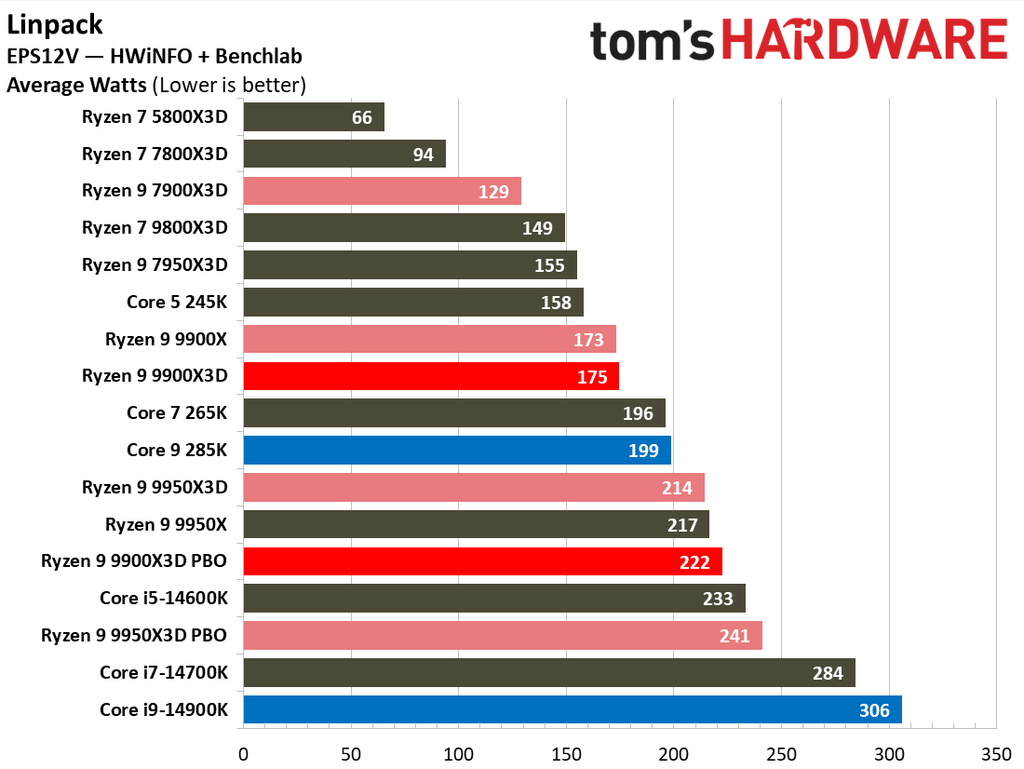
(Image credit: Tom's Hardware)
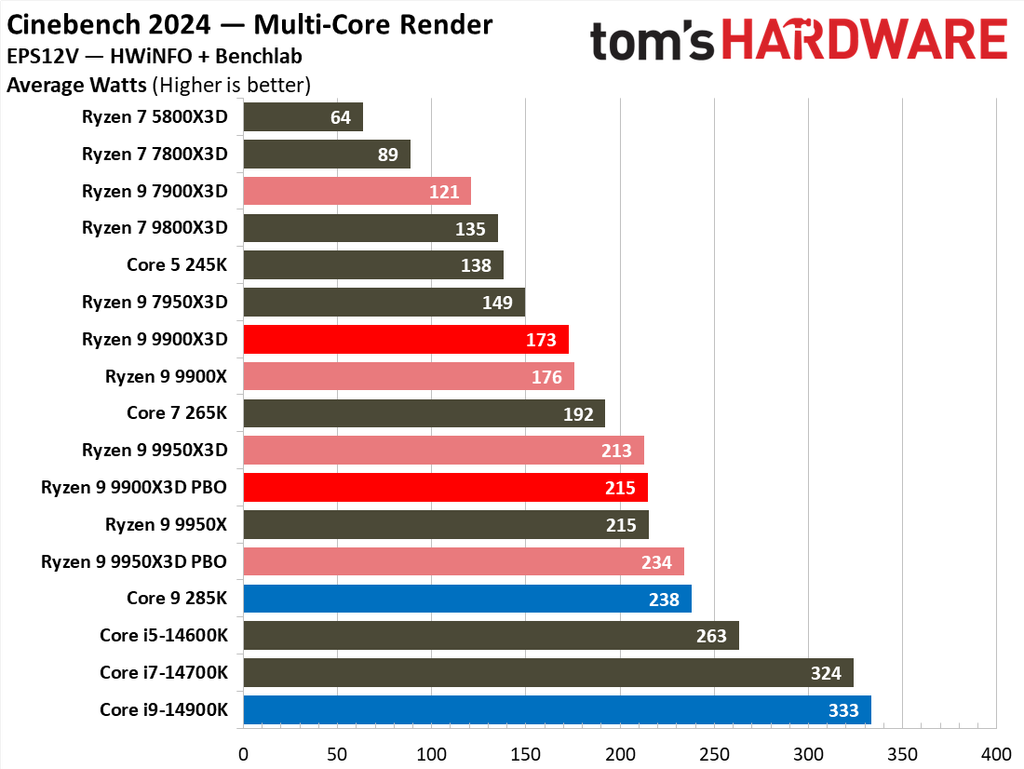
(Image credit: Tom's Hardware)
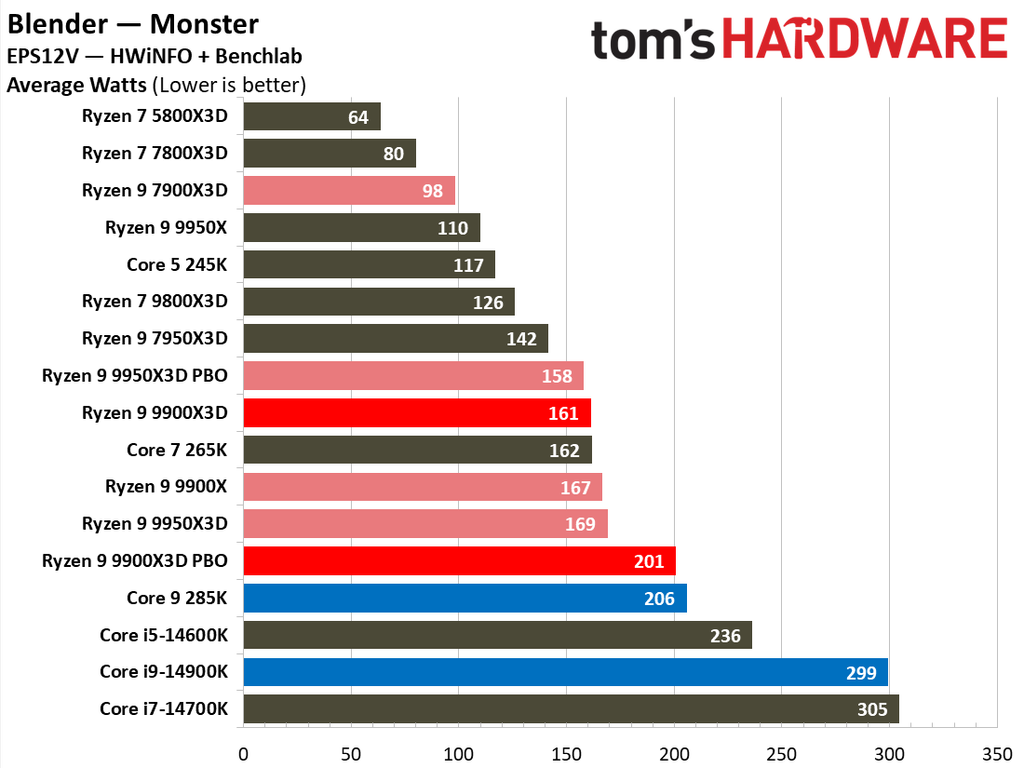
(Image credit: Tom's Hardware)
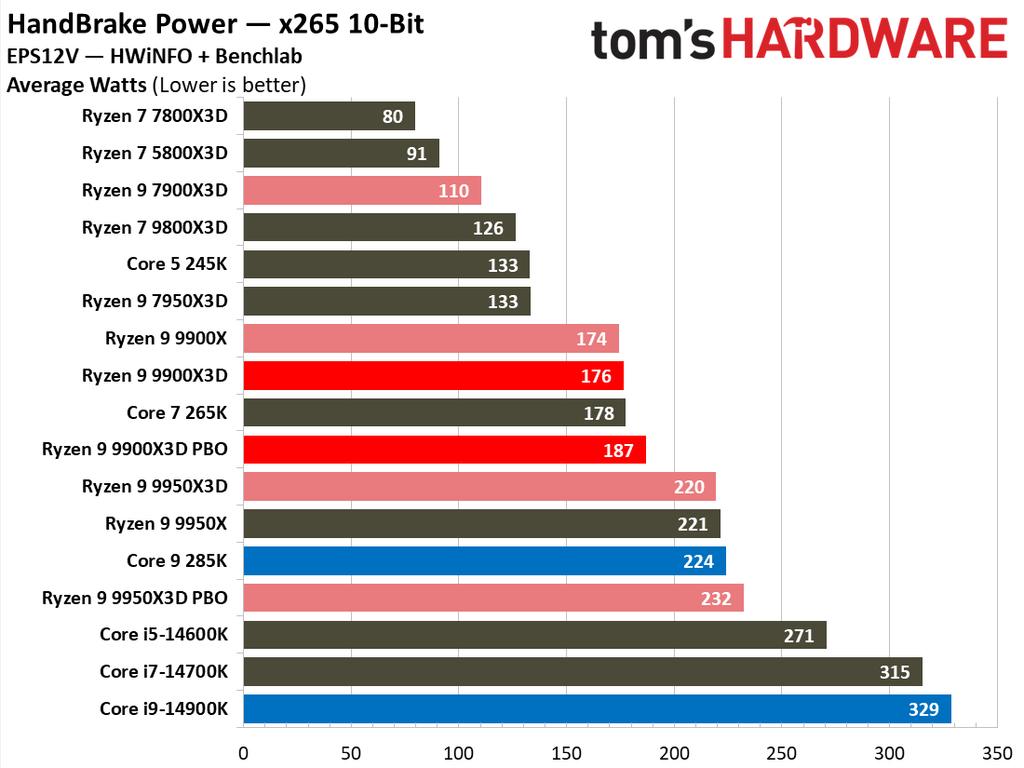
(Image credit: Tom's Hardware)
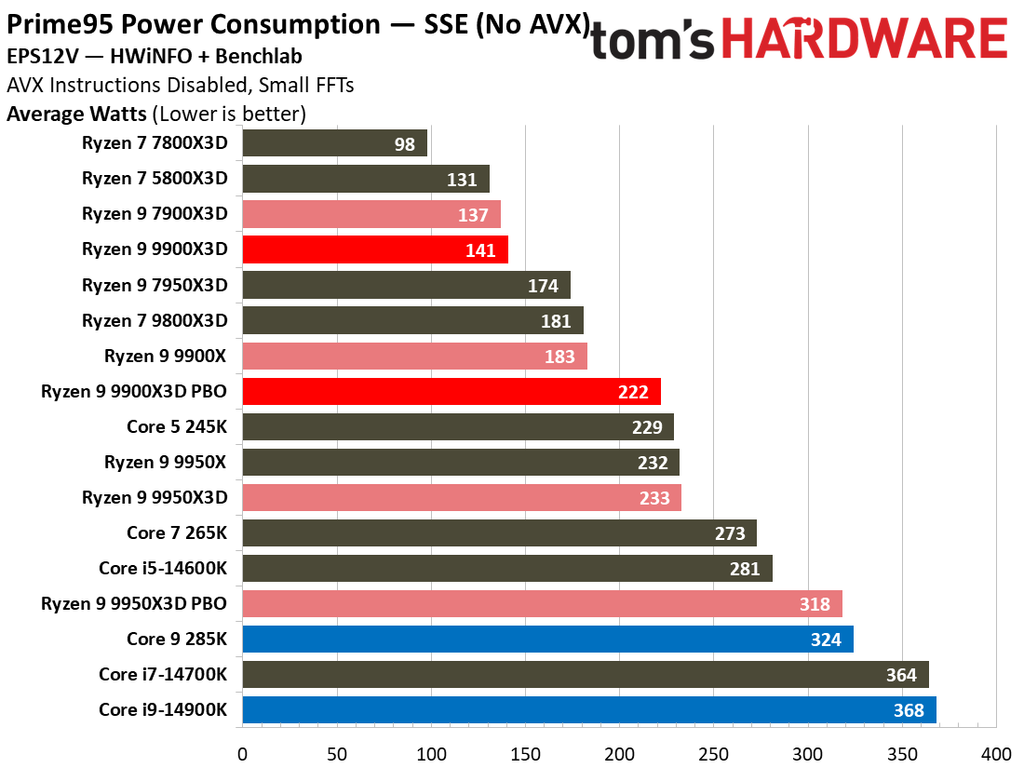
(Image credit: Tom's Hardware)
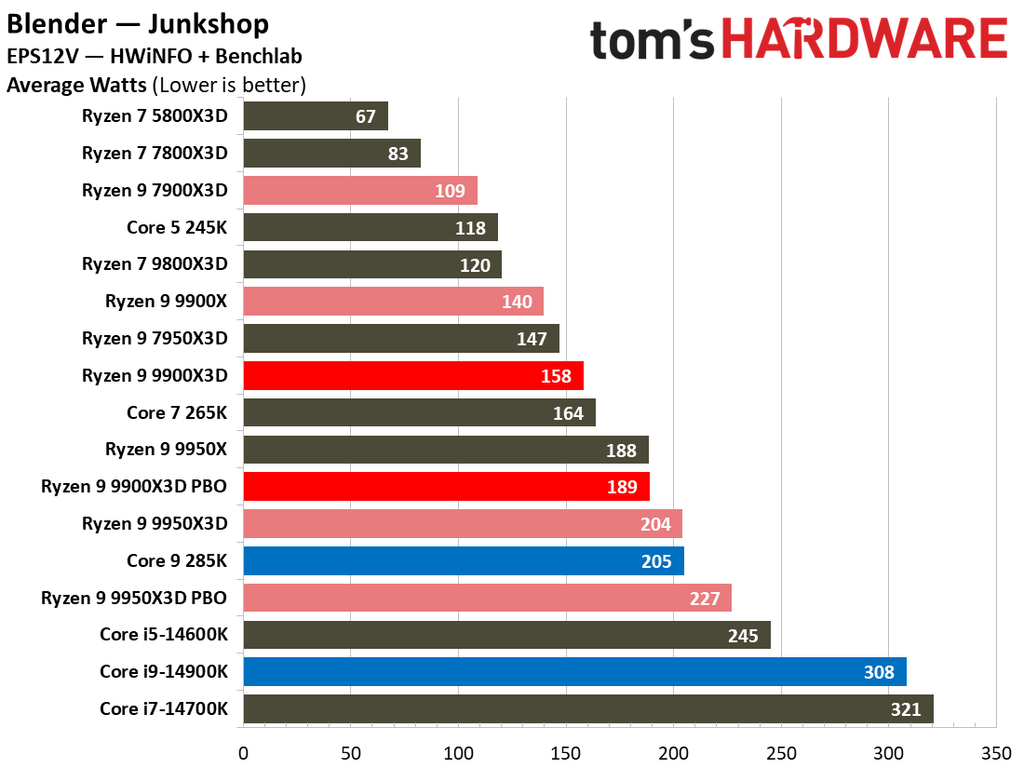
(Image credit: Tom's Hardware)
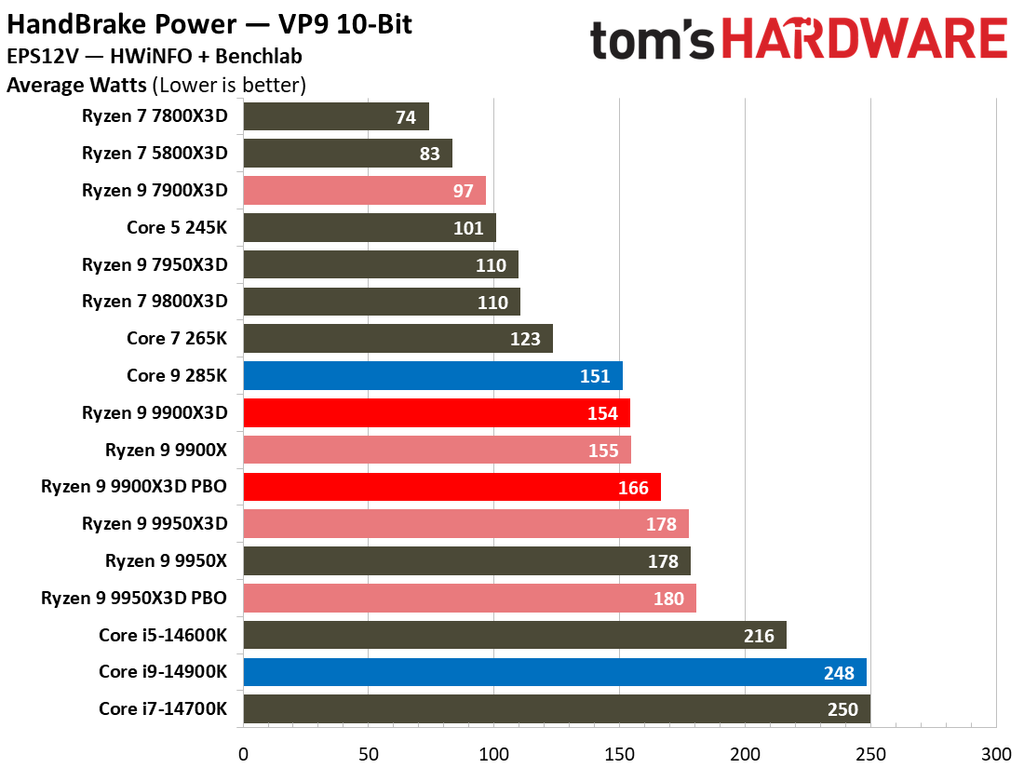
(Image credit: Tom's Hardware)
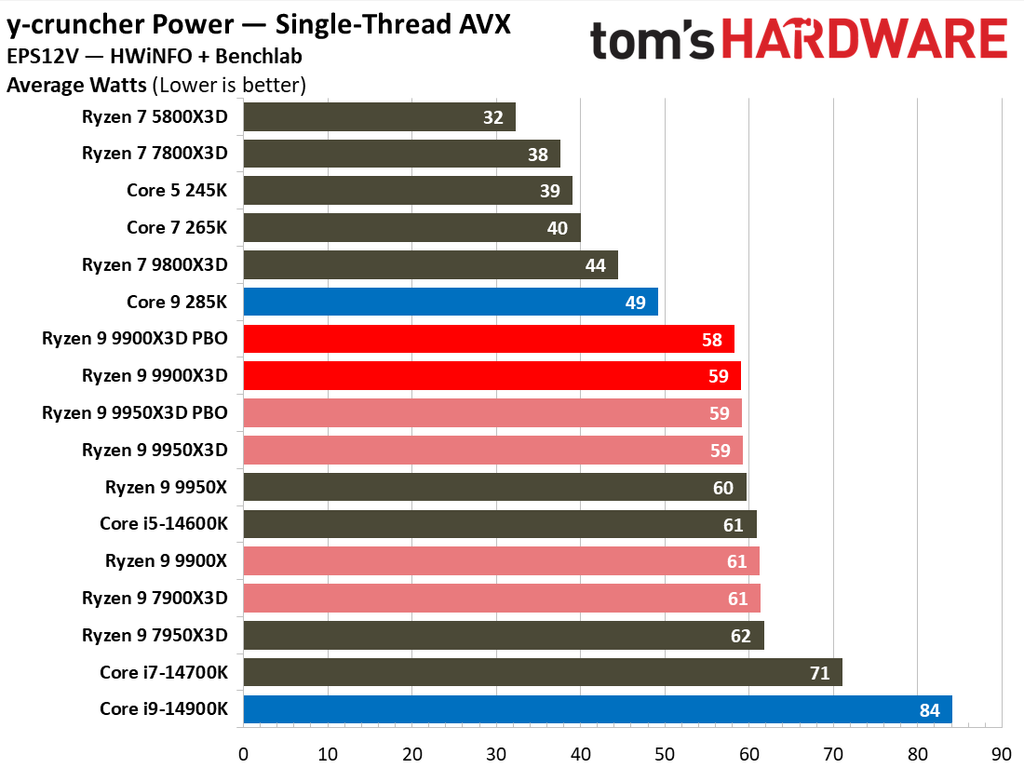
(Image credit: Tom's Hardware)
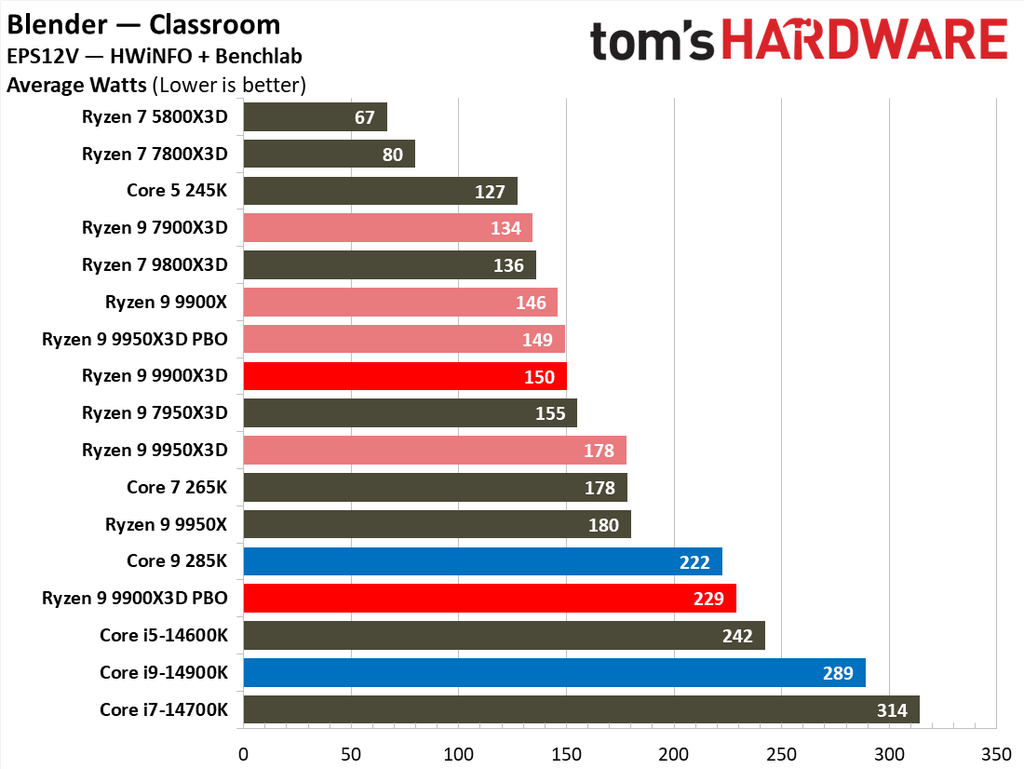
(Image credit: Tom's Hardware)
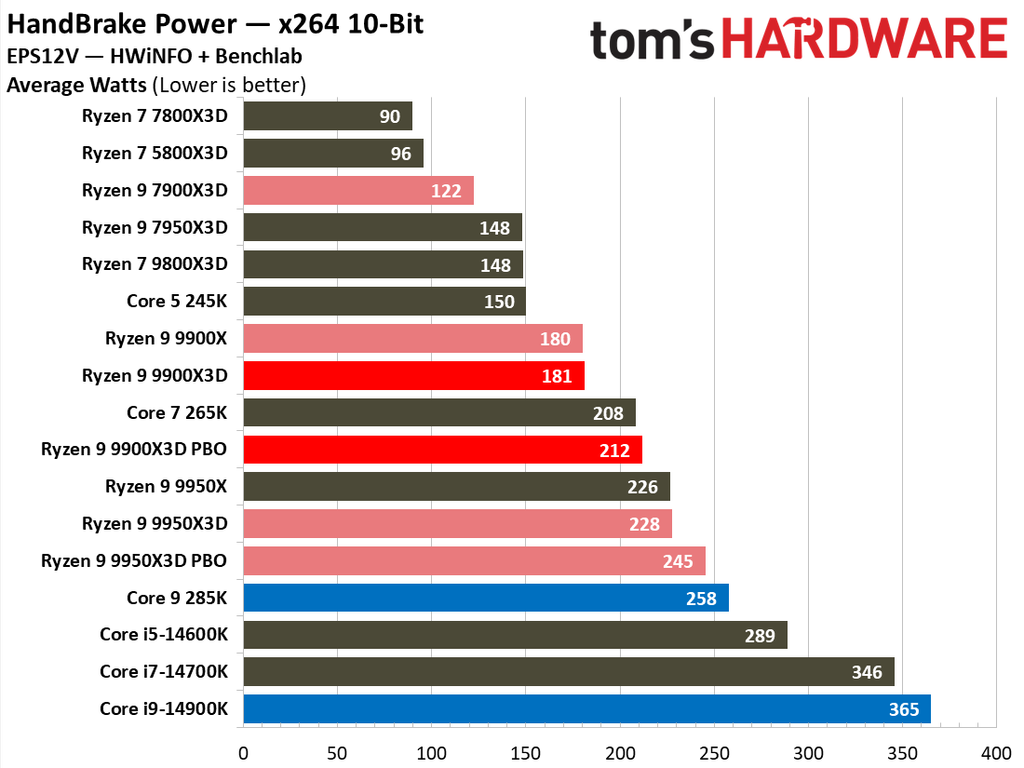
(Image credit: Tom's Hardware)
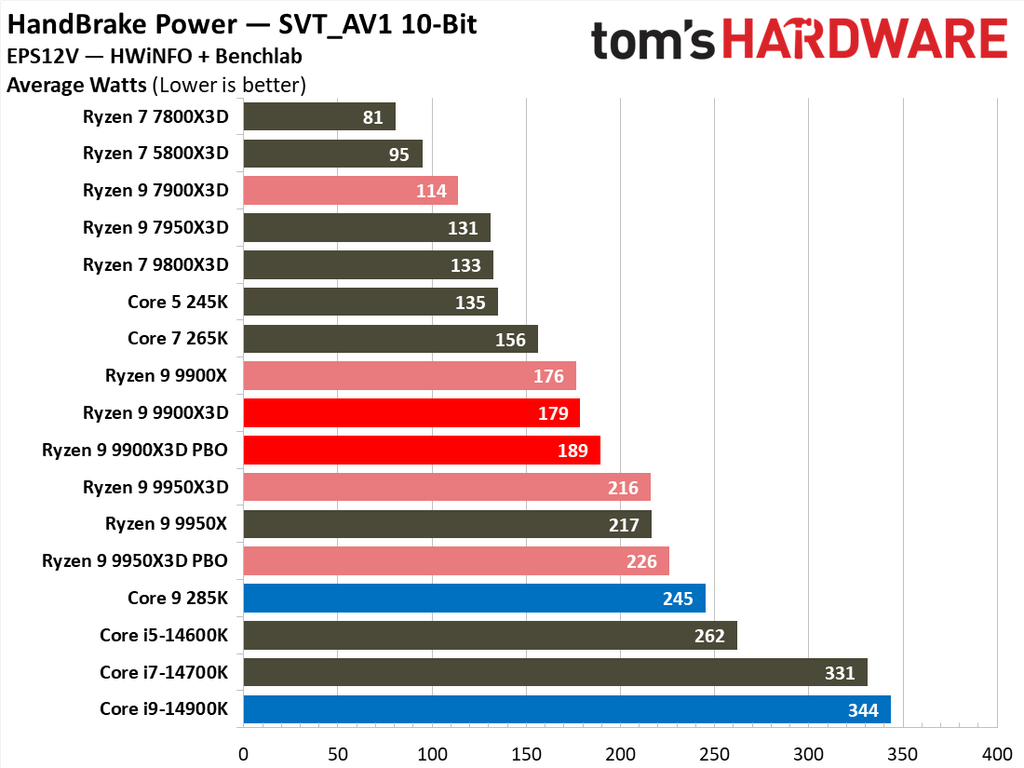
(Image credit: Tom's Hardware)
Overall, Intel has reduced its power consumption from meme-worthy to an acceptable level, but it still consumes more power than Ryzen. Still, in aggregate, AMD's 4nm chips either consume less power or provide much better power-to-performance efficiency.
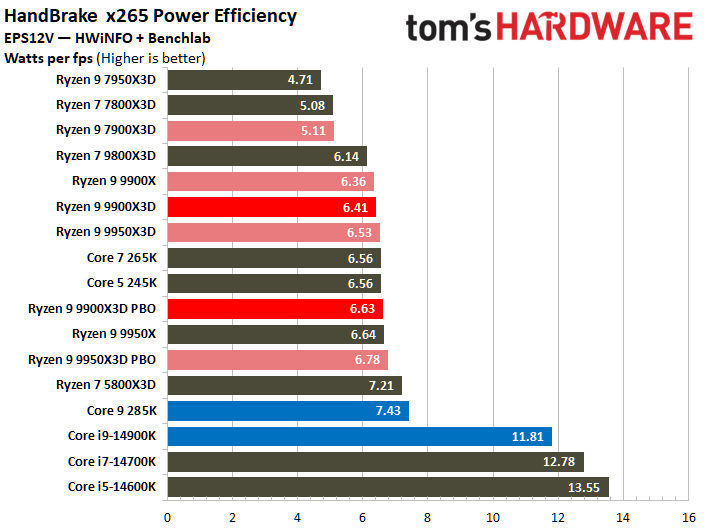
(Image credit: Tom's Hardware)
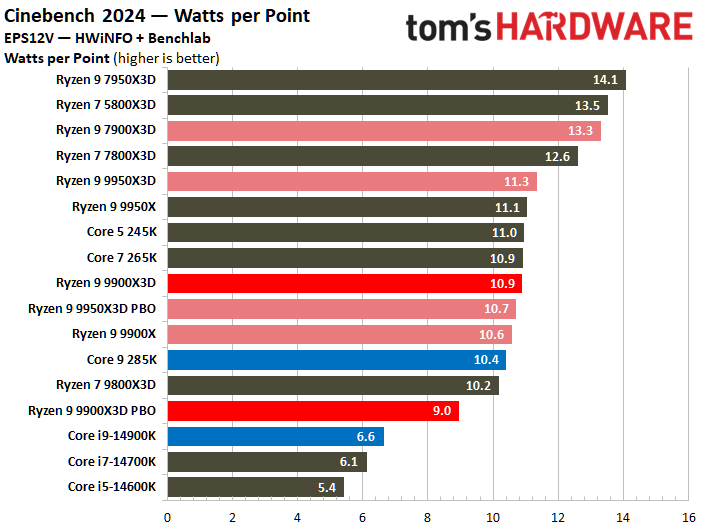
(Image credit: Tom's Hardware)
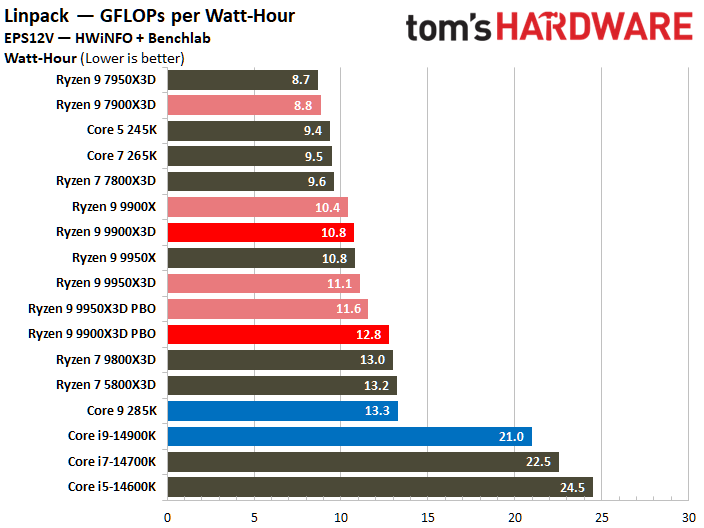
(Image credit: Tom's Hardware)
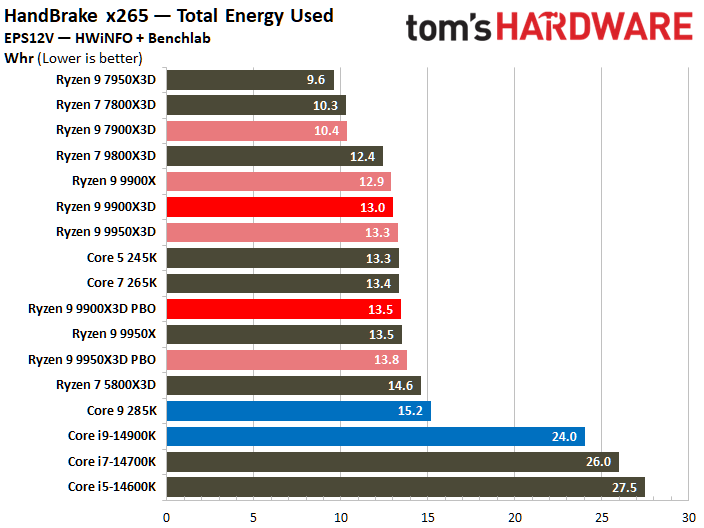
(Image credit: Tom's Hardware)
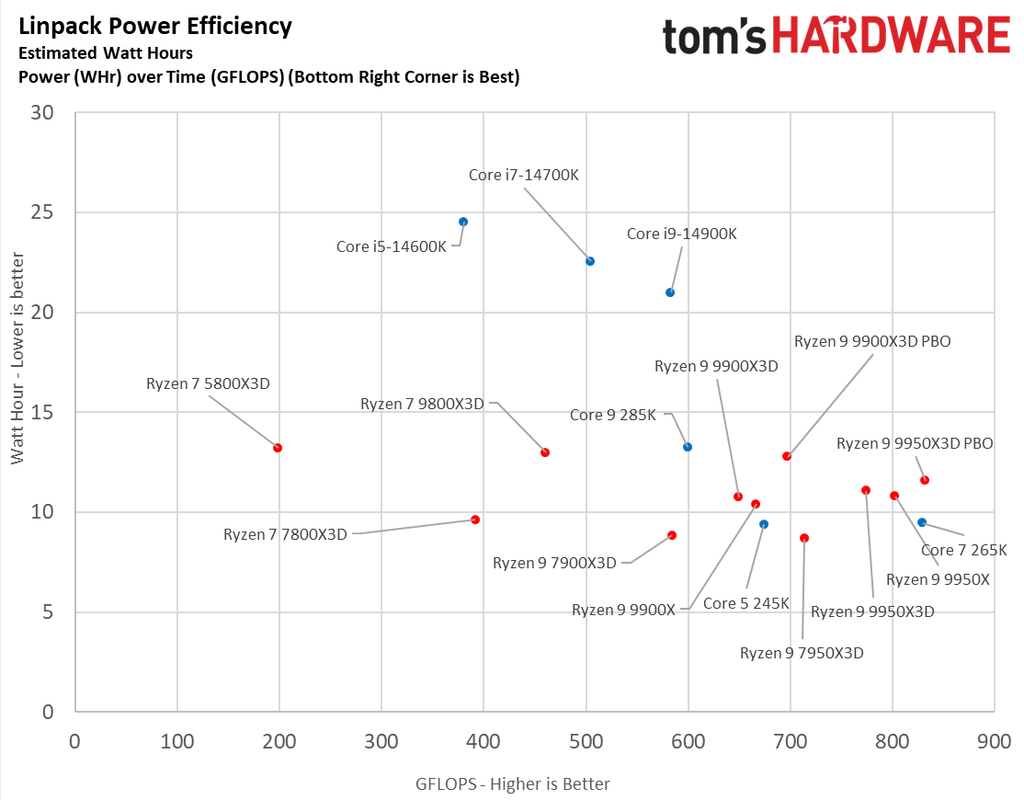
(Image credit: Tom's Hardware)
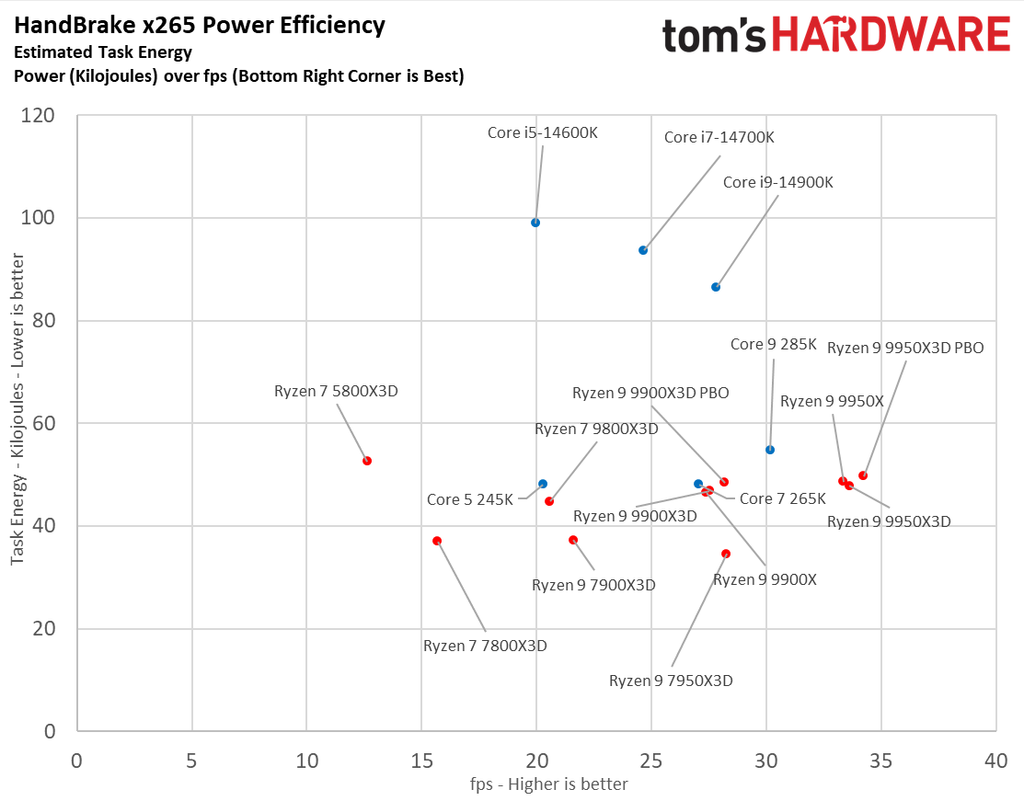
(Image credit: Tom's Hardware)
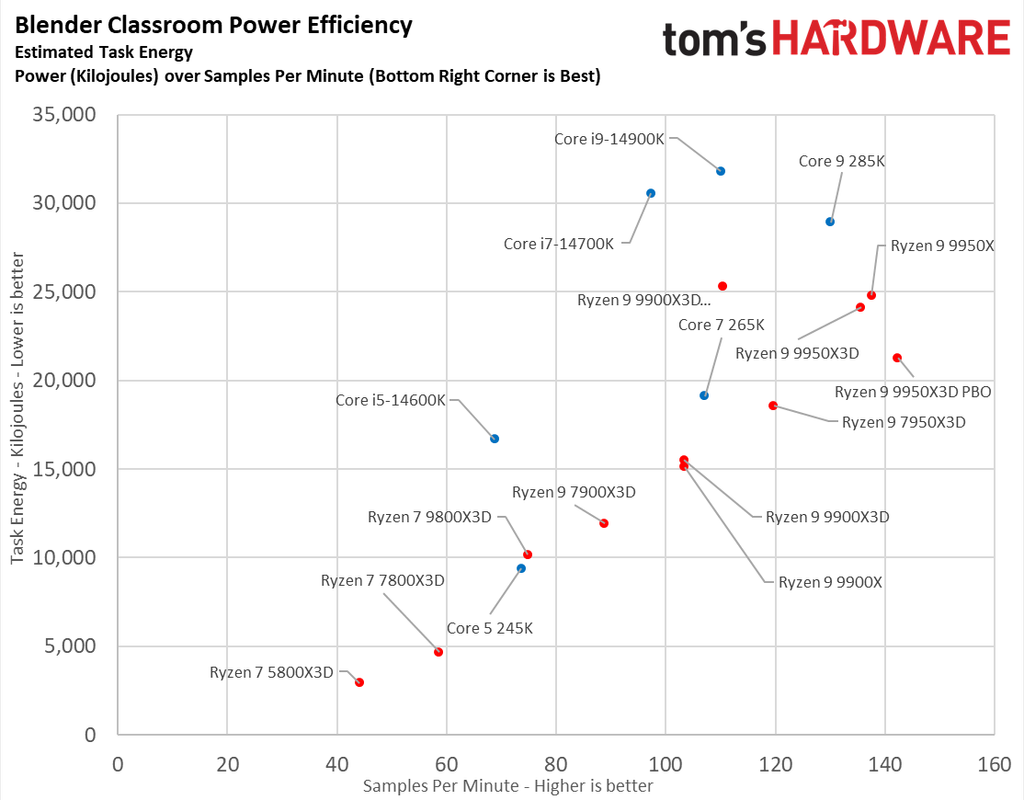
(Image credit: Tom's Hardware)
As you can see above, you'll get more work done per watt of energy consumed, which is a win-win, and AMD's cooling requirements aren't nearly as overbearing.
Winner: AMD. In judging AMD vs Intel CPU performance per watt, it's impossible to overstate the importance of having the densest process node paired with an efficient microarchitecture, and TSMC's 4nm and AMD's Zen 5 are the winning combination. The latest Ryzen processors consume less power than Intel on a power-vs-performance basis.
Intel vs AMD CPU Overclocking
There's no debate when you compare Intel vs AMD CPU overclocking. Intel offers the most overclocking headroom, meaning you can gain more performance over the baseline speed with Intel chips than you can with AMD's Ryzen processors. To learn more about overclocking, head to our How to Overclock a CPU guide.
As mentioned, you'll have to pay a premium for Intel's K-Series chips and purchase a pricey Z-Series motherboard, not to mention splurge on a capable aftermarket cooler (preferably liquid), to unlock the best of Intel's overclocking prowess. However, Intel's chips are relatively easy to push to their max, though gains can be slim in some applications.
Intel doesn't allow full overclocking on B- or H-series motherboards, but it has infused memory overclocking into its B560 and H570 chipsets, and that works with any chip that is compatible with the platform.
AMD doesn't have as much room for manual tuning. In fact, the maximum achievable all-core overclocks often fall a few hundred MHz beneath the chips' maximum single-core boost. That means all-core overclocking can actually result in losing performance in lightly threaded applications, albeit a minor amount.
Part of this disparity stems from AMD's tactic of binning its chips to allow some cores to boost much higher than others. In tandem with AMD's Precision Boost and innovative thread-targeting technique that pegs lightly-threaded workloads to the fastest cores, AMD exposes near-overlocked performance right out of the box. That results in less overclocking headroom.
However, AMD offers its Precision Boost Overdrive. This one-click auto-overclocking feature will wring some extra performance out of your chip based on its capabilities, your motherboard's power delivery subsystem, and your CPU cooling. AMD's approach provides the best performance possible with your choice of components and is generally hassle-free. In either case, you still won't achieve the high frequencies you'll see with Intel processors, but you do get a free performance boost. AMD has also vastly improved its memory overclocking capabilities.
Winner: Intel. When it comes to AMD vs Intel CPU overclocking, Team Blue has far more headroom and much higher attainable frequencies. Just be prepared to pay for the privilege – you'll have to buy a K-series processor. Intel has added memory overclocking to the newest B- and H-series motherboards, which is an improvement.
AMD's approach is friendlier to entry-level users, rewarding them with hassle-free overclocking based on their system's capabilities, but you don't gain as much performance.
Intel vs AMD CPU Drivers and Software
When we look at AMD vs Intel CPU software support, Team Blue has a stronger reputation. AMD has suffered plenty of issues with its CPU and chipset drivers, a natural byproduct of its limited resources compared to its much-larger rivals. Intel isn't without its missteps on the driver front, but its reputation for stability helped earn it the top spot in the processor market, particularly with OEMs.
You might be a little more cautious when approaching Intel's more exotic solutions, though. In the past, the company has developed innovative new products that have been relegated to the dustbin of history due to pricing and market forces, and long-term support for those products might not always be clear-cut.
AMD still has its work cut out for it. The company has had several issues with BIOS releases that failed to expose its chips' full performance, though AMD has mostly solved those issues after a long string of updates. As a side effect of being the smaller challenger, AMD also faces a daunting challenge in offsetting the industry's incessant optimization for Intel's architectures above all others.
Intel also continues to face challenges, though. The company's Core Ultra 200S architecture uses large performance cores (P-cores) and small efficiency cores (E-cores) for different types of tasks, and other elements, like I/O and the GPU, are placed on separate tiles/dies, which complicates matters. Placing the correct workloads on the correct cores requires a new Intel Thread Director technology, but that means some programs might need extra handholding to extract the best performance in Windows 10.
Winner: Intel wins the battle of AMD vs Intel CPU drivers and software. Over the last few years, Intel has addressed its laggardly driver updates for its integrated graphics, and the company has an army of software developers at its disposal that help ensure its products get relatively timely support with the latest software. AMD has made amazing progress convincing the developer ecosystem to optimize for its new Zen architectures. However, there's still plenty of work to be done as the company moves forward.
AMD vs Intel CPU Security
The last few years have found security researchers poking and prodding at the speculative execution engine that's one of the key performance-boosting features behind all modern chips. The resulting research has spawned an almost never-ending onslaught of new vulnerabilities that threaten the safety of your system and private data. Unfortunately, these types of vulnerabilities are incredibly dangerous because they are undetectable—these tactics steal data by using the processor exactly as it was designed; thus, they are undetectable by any known anti-virus program.
The rash of fixes required to plug these holes also continues to grow, and many of them result in reduced performance. That's particularly painful for Intel because it suffers from more of these vulnerabilities than other vendors. The company has developed in-silicon mitigations with newer processors that can reduce or eliminate the performance overhead, but some older processors are subject to drastic reductions in performance.
AMD isn't immune to vulnerabilities, though. It's hard to ascertain if the initially limited speculative execution vulnerability discoveries in AMD processors were due to a security-first approach to hardened processor design, or if researchers and attackers merely focused on Intel's processors due to their commanding market share: Attackers lmost always focus on the broadest cross-section possible. We see a similar trend with malware being designed for Windows systems, by far the predominant desktop OS, much more frequently than MacOS, though that does appear to be changing.
However, AMD has also had several other new vulnerability disclosures in the recent past, including a Meltdown-esque variant that requires software re-coding. Like Intel, AMD has made a few targeted in-silicon fixes for its newer Ryzen processors, thus lowering its exposure to vulnerabilities.
However, newer vulnerabilities and hacks continue to present issues for chipmakers. For instance, computer motherboard maker MSI was recently hacked, leading to its OEM private keys, used for verifying firmware to a computer's secure boot mechanisms, being released to the public. This puts an untold number of PCs at risk from fake drivers and firmwares.
Winner: AMD. The AMD vs Intel CPU security debate continues to evolve as researchers and nefarious actors alike turn more of an eye towards AMD's newer architectures. As things stand, Intel still suffers from more known vulnerabilities than AMD, and the impact of the Spectre mitigations on previous-gen Intel processors leads to larger performance losses (at times equivalent to a few generational gains worth of improvement) than the fixes we've seen from AMD, granting Team Red the win.
- MORE: Best CPUs for Gaming
- MORE: CPU Benchmark Hierarchy
- MORE: Zen 4 Ryzen 7000 All We Know
- MORE: How to Overclock a CPU
- MORE: How to check CPU Temperature
- MORE: All CPUs Content

-
 C114 Communication Network
C114 Communication Network -
 Communication Home
Communication Home


